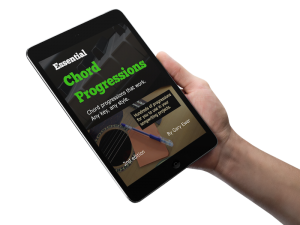There is a lot to be said for the chords-first songwriting process, not the least of which is the fact that when you start vamping on a chord progression, a mood usually becomes quickly obvious. And once you’ve got the mood of the music, a topic will often be easier to settle on.
And once you’ve got the topic, lyrics start to happen. So the chords-first songwriting process can work well for you, and work quickly.
 There’s more to a song hook than meets the ear… a lot more. “Hooks and Riffs: How They Grab Attention, Make Songs Memorable, and Build Your Fan Base” is a vital manual for any serious songwriter.
There’s more to a song hook than meets the ear… a lot more. “Hooks and Riffs: How They Grab Attention, Make Songs Memorable, and Build Your Fan Base” is a vital manual for any serious songwriter.
There’s one major pitfall that can happen with the chords-first process, and it has to do with melody: a chords-first method often leaves melody as something that can get ignored.
So instead of a melody with a nice shape that you could imagine to be like a kind of line, you get instead a melody that tends to sit on one or two notes, not really having any kind of obvious shape.
It doesn’t need to be that way, of course. Once you’ve got a chord progression you like, switch your attention immediately to the melody, and you’ve got a better chance of writing a tune that’s attractive and well-contoured.
But for my own writing, I like to start with the melody. You may feel that melody-first is a tricky process to get a handle on, but you’ll likely find that it’s easier than you thought it would be.
It’s easier because a melody usually implies the chords that might go with it. In other words, you’re not likely to imagine or improvise a melody that just wanders aimlessly everywhere, sounding like your cat walking on the keyboard.
To prove this to yourself, try creating a simple two-chord progression, maybe something like: C-Am. Play it a few times, now start focusing on improvising a melody. You’ll likely find that the melody you invent will fit nicely into that two-chord pattern.
And because you’ve switched your attention to melody, you’ve got an opportunity to make that melody whatever you need it to be. And you’re more likely to create a melody that’s got a memorable shape — something that’s really important for enticing people to return to your song.
Once developing the melody in this way gets easier, try improvising melodies without any chord vamping at all. Just clear your mind for a few seconds, and start humming. You might be surprised by how interesting your melodies become.
And once you’ve got a melody, you usually find that you’ve got a lot of options for creating chords that will support it.
In that regard, I’ve always found the melody-first process to be the most freeing and creative songwriting process out there. Give it a try!
 Written by Gary Ewer. Follow Gary on Twitter.
Written by Gary Ewer. Follow Gary on Twitter.
 Looking for lists of progressions you can use in your own songs? “The Essential Secrets of Songwriting” eBook Bundle has 2 main collections, plus eBooks on how to harmonize your own melodies, and more.
Looking for lists of progressions you can use in your own songs? “The Essential Secrets of Songwriting” eBook Bundle has 2 main collections, plus eBooks on how to harmonize your own melodies, and more.










